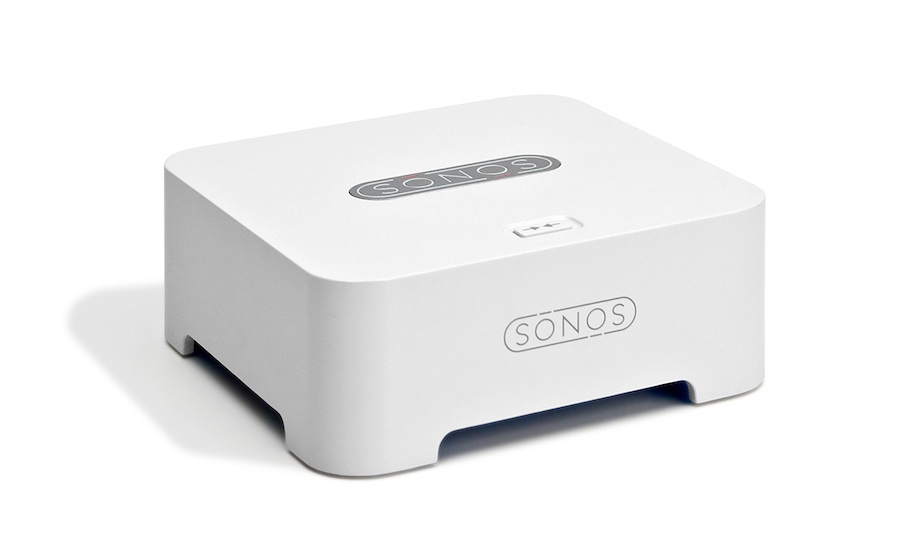Review: Sonos S5 ZonePlayer and 3.4 System Update Page 2

SETUP
The key to the Sonos system (aside from it's almost Apple-like simplicity) is SonosNet, a proprietary mesh network connecting the company's playback units and wireless bridges. Assembling a Sonos system requires that one of the units be connected to your home network via a hard-wired Ethernet port, but that's for communication with your computers, network attached media storage, and the Web for streaming services such as Pandora, SiriusXM, and MOG (newly added this week) - all local audio streaming takes place over the closed SonosNet, free from the interference it'd be likely to run into on a general-use Wi-Fi setup. And it works very well.
Setup of the Sonos system itself couldn't be simpler (I used two of Sonos' recent S5 units, networked with and without a ZoneBridge). Connect a Sonos unit to your router (a ZonePlayer if you need playback in the room where your internet connection is located; a ZoneBridge if not), place your ZonePlayers wherever you like, install the Sonos Controller software on a computer attached to the network, and add your ZonePlayers to SonosNet (select "Add ZonePlayer" from the desktop, press a couple of buttons on the target device, and you're done).
Once the network is established, you direct the Sonos desktop application to search your computers and network attached drives for music. It'll copy an index of your music files (along with your iTunes playlists and album art) to your ZonePlayers (this took less than an hour for about a half-terabyte of files stored on a drive attached to an Apple AirPort Extreme), and you're ready to start listening.
 Sonos' addition of AirPlay to their existing system is a bit of a kludge, though a fairly elegant one. The company has added a new feature to version 3.4 of the Sonos system software, enabling automatic source switching once a Sonos ZonePlayer detects signal at its auxiliary analog line input; adding an AirPort Express wireless router/repeater ($99) - a native AirPlay device, with an analog output - to the mix, and connecting it to a ZonePlayer via that line input provides de facto AirPlay compatibility, if not the totally seamless integration one might hope for. You're basically using the Express as a Wi-Fi antenna for your Sonos system - you're advised to turn off it's own wireless broadcasting, and to connect it via Ethernet cable to a ZonePlayer. A bit more work than is traditional with Sonos' own hardware, but the included manual lays everything out clearly.
Sonos' addition of AirPlay to their existing system is a bit of a kludge, though a fairly elegant one. The company has added a new feature to version 3.4 of the Sonos system software, enabling automatic source switching once a Sonos ZonePlayer detects signal at its auxiliary analog line input; adding an AirPort Express wireless router/repeater ($99) - a native AirPlay device, with an analog output - to the mix, and connecting it to a ZonePlayer via that line input provides de facto AirPlay compatibility, if not the totally seamless integration one might hope for. You're basically using the Express as a Wi-Fi antenna for your Sonos system - you're advised to turn off it's own wireless broadcasting, and to connect it via Ethernet cable to a ZonePlayer. A bit more work than is traditional with Sonos' own hardware, but the included manual lays everything out clearly.
 Once you've hooked everything up, you send audio from iTunes (or another AirPlay-enabled application) on your Mac, PC, smartphone, or tablet to the AirPort Express, the ZonePlayer senses the input, and automatically switches over from whatever it's doing - it's pretty seamless in practice. Any ZonePlayer can broadcast whatever's present at its line input to other Sonos devices on the network, so by adding an Express to a single ZonePlayer you can then broadcast over AirPlay to your entire Sonos system - very cool.
Once you've hooked everything up, you send audio from iTunes (or another AirPlay-enabled application) on your Mac, PC, smartphone, or tablet to the AirPort Express, the ZonePlayer senses the input, and automatically switches over from whatever it's doing - it's pretty seamless in practice. Any ZonePlayer can broadcast whatever's present at its line input to other Sonos devices on the network, so by adding an Express to a single ZonePlayer you can then broadcast over AirPlay to your entire Sonos system - very cool.
Setting up the Android app was in keeping with the usual Sonos simplicity: I downloaded and installed the software, at the prompt I held down the Mute and Volume Up buttons on a nearby ZonePlayer, and I was up and running - the interface is slick and its multiple screens (for browsing your library, streaming services and music queue, playing tracks, and adjusting player and network settings) duplicate the desktop software; everything is easily and intuitively navigable with a few swipes.





























































